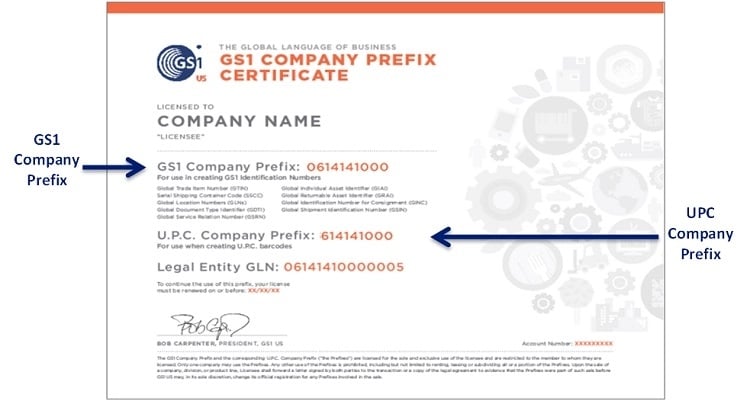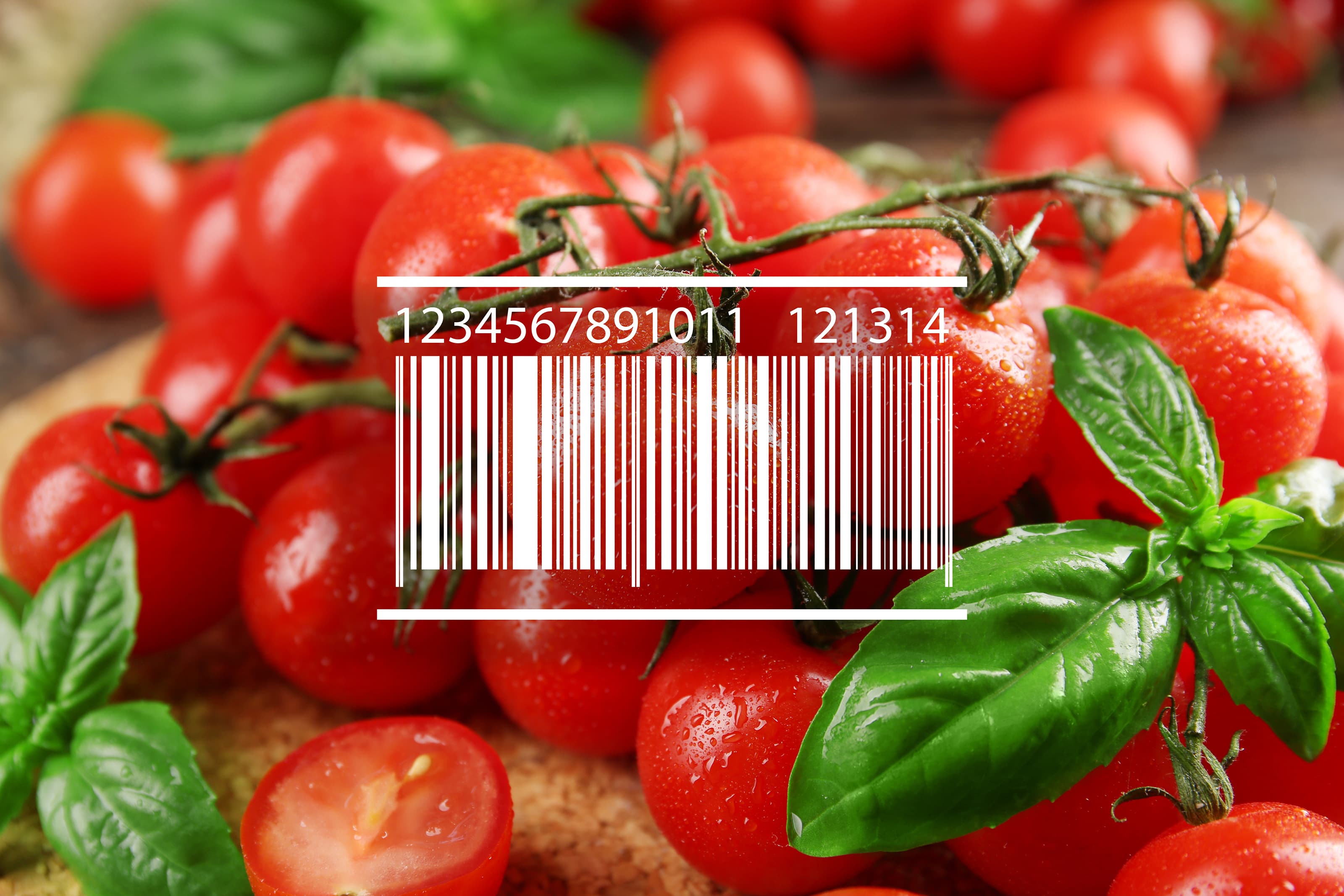The GS1 DataBar is a stacked omnidirectional barcode created by the global standards organization, GS1. The GS1 DataBar was designed to fit on small loose produce items that are not large enough to accommodate a UPC barcode. The barcode is printed on a PLU sticker and supplemented by the 4- or 5-digit PLU code as the human readable portion. The PLU code can be used as a back up as it can be entered manually at the point of sale if the barcode does not scan. It is important to reiterate that the GS1 DataBar is used for loose produce and not packaged produce (e.g. bags or clamshells) or case-level identification. If a larger individual produce item has a UPC barcode (e.g., watermelon), it does not need to have a separate GS1 DataBar created.
The GS1 DataBar is encoded with a 14-digit Global Trade Item Number or GTIN. It enables the capture of brand-owner identification for loose produce instead of only the category of the item via the PLU code. Although it will identify the brand owner, it does not contain information to assist with full traceability efforts (i.e., batch/lot number or pack date).
Benefits of GS1 DataBar
The implementation of GS1 DataBar barcodes on PLU stickers has many advantages to both retailers and suppliers.
- Improved category management
- Increased checkout speed
- Improved inventory accuracy
- Enhanced product quality management efforts
- More products automatically and accurately identified at point of sale
- Shrink control via front-end accuracy
- Facilitated self-checkout
The PLU sticker with the 4- or 5-digit PLU code alone provides information required to charge the correct price at the point of sale but provides limited information for category management.
Retailers who successfully implement the GS1 DataBar barcode for scanning realize many benefits. The point-of-sale (POS) transaction time is reduced from 4 seconds to manually key the 4- or 5-digit PLU code to 1 second to scan the barcode. They are able to implement category management down to supplier and item level and can determine the sell through (retail units sold vs. purchased) by item and by supplier. This information can indicate the effectiveness of each supplier's cold chain and guide the retailer’s decision as to which suppliers they purchase from. Retailers are also able to understand sales and profits by supplier and by variety, no longer just at the item or category level.
Retailers can use the data to enhance their Computer Assisted Ordering process and, when dealing with a recall, can verify which stores scanned the recalled product and take appropriate action based on this information.
Gross margins increase due to scanning accuracy, eliminating the potential for human error that can occur when using manual PLU entry. Many cashiers memorize PLU codes or sometimes enter them incorrectly. Some do not read the PLU sticker, assuming the product is conventional when it is organic or enter the wrong PLU code. Not all red apples are Red Delicious!
Customers using the self-checkout stations report increased satisfaction with the process when GS1 DataBar scanning is enabled.
The benefits of GS1 DataBar to suppliers are discrete visibility of their product’s quality, sell through and shrink in each of their customer’s supply chains, brand differentiation and category management that facilitates collaboration with retailers and longer term planning.
Transitioning From PLU Code to GS1 DataBar
For each PLU-coded product you sell, you will need to create a corresponding 14-digit GTIN using the following steps:
- Obtain a GS1 Company Prefix
Contact GS1.
- Create your 14-digit company-specific GTIN.
GS1 Company Prefixes will rannge in length from 7 to 11 digits, depending on the company’s capacity, so item reference number lengths will also vary as indicated in the following chart.
Number of items Company prefix length Item reference number length 99,999 7 digits 5 digits 9,999 8 digits 4 digits 999 9 digits 3 digits 99 10 digits 2 digits 9 11 digits 1 digit
Formatting the GTIN for DataBar
The GS1 Stacked Omnidirectional DataBar has a 14-digit data structure for the product identification number.
For the United States and Canada, the 14-digit GTIN for the GS1 DataBar is built using the GTIN-12 and includes the following components:
- Indicator Digit: Used to define the packaging hierarchy of a product. This number is always a “0” for loose or bulk items.
- GS1 Company Prefix: A number assigned by GS1 that uniquely identifies a company from any other company in the world. (The GS1 Company Prefix is the UPC Company Prefix with a preceding zero added.) Contact GS1 to obtain your Company Prefix or for more information.
- Item Reference Number: Assigned by the owner of the GS1 Company Prefix to identify the item; the length is based on the length of the prefix.
- Check Digit: The last digit which is calculated by an algorithm and serves as a “checks and balances” to ensure the preceding digits were entered correctly. To calculate the check digit, use the Check Digit Calculator.
For the Rest of the World, the 14-digit GTIN is built using the GTIN-13.
Begin with the Indicator Digit, which is always '0' for the GS1 DataBar for loose produce.
Follow with the GTIN-13 for the item.
It is not advised to assign the PLU code as the item reference number (e.g., a company having an 8-digit or 9-digit Company Prefix will not have enough digits to use a 4-digit PLU as an item reference number). The owner of the Company Prefix can assign whatever numbers they wish as the item reference number, but it is suggested that no intelligence is built into the Item Reference Numbers. Instead, start with the number '0' and continue to assign the numbers in sequence for all items in your product catalog.
It is recommended that GTINs are assigned to your items using the same granularity as the PLU code (Commodity, Variety, Size Group). As most retailers' systems are used to this level of granularity, it will make the transition much easier if each companies' GTINs equate to this level of granularity.
There are label manufacturers available to assist with the creation of the GS1 DataBar on your PLU stickers.
DataBar Implementation Guide
The International Federation for Produce Standards (IFPS), in collaboration with the industry and GS1 organizations, released the Implementation of GS1 DataBar for the Global Fresh Produce Industry. This guide was created as a resource to assist with implementation of GS1 DataBar.
This guide explains what a GS1 DataBar is, the benefits and challenges of implementation, the steps to begin using the GS1 DataBar, the regional requirements of Australia, Canada, Mexico and the United States as well as Frequently Asked Questions for additional guidance.
This resource is available for download on the Resources page of the IFPS website.
PLU Code Experts


